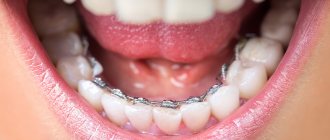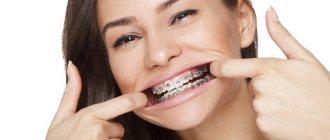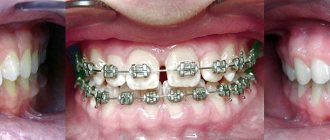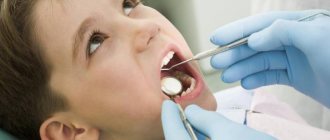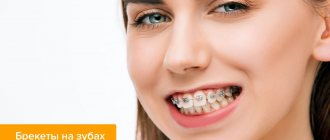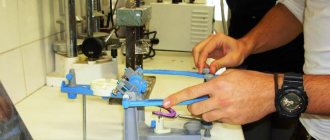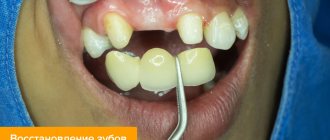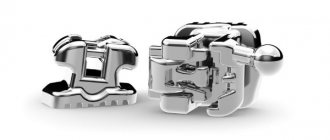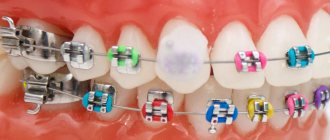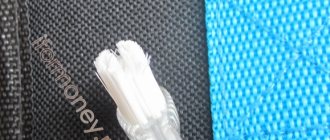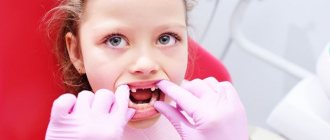2153
Orthodontics is a relatively young branch of dentistry. But today it has reached a high level.
If a few years ago braces were bulky and scary-looking, and treatment of dental pathologies took years, now everything is completely different.
Bracket systems have become more aesthetically pleasing, and correction is faster. And all this thanks to the development of innovative techniques and materials, improvement of design details.
But, as before, it is often necessary to change their main element - the arc.
Duration of treatment and frequency of revisions
The duration of wearing any system in the mouth varies depending on the complexity of the defect.
Below are the averages:
- Mild form – six months;
- Average form – up to one and a half years;
- High degree of curvature – up to 2.5 years.
The timing is affected by the individual characteristics of the jaw - some people straighten their teeth faster than the indicators indicated above, while others have to wear systems longer.
How often do archwires need to be changed?
The bracket system consists of:
- Braces. Small iron clasps located in the middle of the tooth rarely require reconstruction. Exceptions are the consequences of blows to the jaw or poorly chosen hard food.
- Ligature . Simply put, elastic bands for securing the power element in the grooves of the locks.
- Arcs. A metal alloy consisting of a wire, which is the connecting link of the system, distributing uniform pressure on the dentition.
To make the treatment more effective, the power elements are changed, depending on the treatment plan - about 5 times during the entire treatment period.
The time difference is also determined by the doctor during the correction process, so rest assured that the arch can be replaced 5 times with an interval of a month, or 3 times with an interval of 3-4 months.
The arch provides the necessary uniform pressure and traction, while forcing the elements of the jaw row to move in the desired direction.
During movement, the effect of the traction element weakens, so it is impossible to do without replacement.
Let's discuss together how to apply wax to braces so that it effectively protects soft tissues from injury.
Come here to take a closer look at the design of Victory metal braces.
At this address https://zubovv.ru/ortodontiya/breketyi/osnovyi-uhoda-v-period-lecheniya.html we will talk about proper care of braces after installation.
Inhalation of small parts
There are cases of not only swallowing braces, but also inhaling small parts. This situation is considered very dangerous, since there is a risk of the element blocking the access of oxygen to the respiratory organs, including getting into the lungs.
Unfortunately, it is impossible to remove the element from the lung tissue without the help of specialists. A section of a metal arc can block the opening in the trachea or bronchi, thereby causing an attack of suffocation.
If timely assistance is not provided, the patient very quickly begins an inflammatory process, which is accompanied by an abscess.
Self-medication leads to the development of serious complications and poses a direct threat to human life.
In this case, it is necessary to immediately call an ambulance and provide emergency measures to the patient before arriving.
The latches of braces bypass the digestive tract without any consequences and are eliminated naturally. The sharp edges of such a miniature part do not damage the walls of the esophagus, stomach and intestines. A swallowed ligature will not create a problem: a torn elastic one will come out without consequences for health, and a broken wire one will most likely be dissolved by stomach acid.
When part of the arch is swallowed, the doctor may recommend performing an ultrasound of the abdominal cavity. If the element had a sharp edge, when moving along the esophagus it may catch on soft tissue. You can’t eat anything else, so that the fragment doesn’t go lower and penetrate the stomach. The result of the examination will show the location, and modern medical technology will allow you to get it without much difficulty.
Inhalation of small parts is more dangerous for the respiratory tract. Lingering in the lungs, a foreign body can provoke tissue inflammation. Therefore, it should be removed as quickly as possible using a bronchoscope. To perform this simple and quick procedure, doctors do not even use anesthesia.
Patients with braces should always remember: all possible negative consequences of “surprises” that they encounter during treatment can be nullified by timely contacting an orthodontic clinic.
| Doctor: Sudzhaev Sergey Romanovich Patient age: 25 years Diagnosis: distal occlusion, transversal incisal occlusion, crowding of the frontal sections of the upper and lower dentition, edentulous teeth 1.4;2.4;3.4;4.4. Duration of treatment: 12 months Equipment: Clarity SL bracket system | TO THE DOCTOR |
Indications
There are two main indications for replacement:
- Planned procedure. The doctor initially indicates the number of visits to replace the wire. Subsequently, the figure may be adjusted due to individual characteristics.
- The arc has broken or flown out. There are a lot of reasons - incorrect selection of food, shock, poor quality work, insufficient screed.
While wearing the system, you should not eat hard or sticky foods (chewing gum, chewing candies, marmalade, nuts, etc.). Such food contributes to the unsticking of the bracket and there is a risk of deformation or breakage of the structural elements.
Remedies
Unfortunately, the patient does not always have the opportunity to quickly seek medical help if the orthodontic system has rubbed the cheek. You can get rid of discomfort or reduce its severity at home with the help of medications .
Doctors recommend:
- Take a medicine with anti-inflammatory and analgesic effects. Local anesthetics are available in pharmacies without a doctor's prescription. Instructions for use are included.
- Rinse your mouth with a disinfectant solution. This procedure will eliminate signs of inflammation, disinfect the wound, and reduce swelling and pain.
If a person is away from the pharmacy, and the problem requires an emergency solution, you can close the problematic brace that is rubbing with candle wax.
Doctors prohibit the use of tree resin, tar, and chewing gum. Removing one of the listed substances can easily damage the system.
In addition, their surface and structure are an ideal environment for bacterial production, which inevitably leads to the development of infectious processes.
Also, orthodontists advise taking the following measures:
- promptly eliminate the cause of chafing;
- help soft tissues get used to the device;
- treat emerging inflammatory processes and ulcers.
To facilitate the adaptation period, immediately after installing braces, the specialist gives the patient orthodontic wax. This remedy quickly relieves inflammation and prevents further injury to soft tissues.
If the product was not dispensed at the clinic, it can be purchased at a specialized pharmacy.
About the use of orthodontic wax
Dental wax in orthodontics is considered an indispensable means of caring for the braces system and all tissues of the oral cavity.
To go through the therapeutic corrective period with benefit and maximum comfort, it is important to stock up on effective wax for braces.
Pieces of this product can quickly and easily seal problem areas of the system, thereby avoiding their traumatic contact with the mucous membrane. Wax also allows you to disguise unpresentable plates.
In appearance, the material is a mass of dense consistency. The product is made from natural raw materials and medical polymer. The natural component of the product allows you to completely hide the system or its individual sections. And silicone provides the substance with optimal elasticity.
Today, waxes with anti-inflammatory and antiseptic effects are very popular, which perform not only protective, but also therapeutic functions - after use, wounds and scratches heal faster.
Any means used in orthodontics and in medicine in general must be used correctly. Orthodontic wax is no exception. Instructions:
- Thoroughly clean the oral tissues and teeth using a soft-bristled brush;
- dry the surface of the tooth and the problematic plate using a thick cotton swab;
- cut a small piece of wax, strictly controlling the size of the fragment (it should completely cover the bracket that needs to be closed);
- soften the material in your palms and use your fingers to form a small ball out of it;
- attach the resulting ball to the surface of the plate;
- wait a few minutes until the material spreads over the desired area;
- remove excess mass.
Despite the fact that orthodontic wax is considered a hypoallergenic product, doctors insist on removing it before each meal. After eating, the mixture can be applied to the surface of the bracket again.
Remember! Dental wax does not belong to the group of drugs, therefore there are no quantitative or time restrictions in the process of its use.
Using overlays
Small shifts and changes in the corrective structure have an impact on the health of oral tissues and their integrity.
In addition to correcting the bite, orthodontic onlays on the teeth prevent the jaws from completely closing during eating, thereby reducing the risk of injury to the cheeks and lips from the elements of the apparatus.
The work of such overlays is aimed at the following protective functions:
- holding the entire structure in a given position;
- reducing the load on the dental system, apparatus and chewing units;
- protection of oral tissues from inflammatory processes that develop from traumatic contact with parts of the structure.
In orthodontics, onlays are palatal devices with specialized design features. The product includes the following elements:
- metal clasps for fixing the plate;
- an arched element for the lip area (it is a connecting link for clasps);
- bite platform , made in accordance with the jaw structure.
Installation steps:
- installation of bite fillings on the surface of the lateral teeth of the upper and lower jaws;
- corrective actions on onlays using various dental techniques;
- correction of the material as it is erased.
As soon as the adaptation period is completed and the braces stop rubbing the inner surface of the cheeks and lips, the orthodontist painlessly grinds off the braces for the patient.
While wearing such assistive devices, the patient must monitor their condition. If the onlay has crumbled and the braces system has changed its position due to this, it is important to immediately notify the doctor.
Application of silicone
Protective silicone is intended for temporary closure of problematic elements of the corrective apparatus. The product effectively protects tissues from irritation and provides a person with maximum comfort during the treatment process.
Silicone has a long service life and, according to patients, is fixed more reliably than wax.
To use this type of protection, you will need to perform a few simple steps:
- tear off a small piece of material from the entire plate;
- soften it with your fingertips;
- place on the surface of the bracket.
Silicone is able to close all protruding parts of the system, ensuring safe contact of living tissues with foreign parts.
Advantages of the material:
- absolute harmlessness;
- absence of additional impurities;
- increased hypoallergenic properties.
The work of silicone is aimed at the following actions:
- acceleration of adaptation of the mucous membrane to the installed structure;
- protection of living tissues from damage by braces;
- reducing the friction force of the system on the inside of the lips and cheeks;
- preventing friction of the arcuate element with the lock;
- relief of the condition before visiting the doctor after the arch falls out of the grooves.
To make the process of correcting malocclusion easier, experts recommend using other special designs and anti-chafing products.
Here you can highlight special hygiene products, various buttons, as well as elastic cords that increase pressure on the elements of the dental cord in a certain area. The main thing is that the structure has the correct position in the oral cavity and that there are no protrusions.
Is whitening always required after removing braces and what is the best method to use?
In this publication, you can determine the aesthetics of titanium braces from patient photos.
Here https://zubovv.ru/ortodontiya/breketyi/vestibulyarnyie/osobennosti-modeley-sia.html we will look at the design of Sia braces.
Planned manipulations
The arc has the following properties:
- Provides the necessary traction for the movement of the dentition;
- Combines braces into a single system;
Thus, during the treatment process, the traction weakens - the dentition moves and the power element needs to be changed to increase the pressure.
What do they put at the very beginning and what do they replace with?
To avoid painful shock for the first time, a thin wire is placed, which presses on the teeth with little intensity.
During the treatment process, when the teeth adapt, the bond becomes stronger. The material selected is already more rigid.
And each time a power element with rigidity indicators greater than those of previous products is replaced.
Pros and cons of Damon Clear braces, timing of bite correction with transparent systems.
In this publication, we will consider in detail the design of Empower braces.
Here https://zubovv.ru/ortodontiya/breketyi/vestibulyarnyie/foto-keramicheskih.html evaluate the aesthetic indicator of ceramic ligature braces based on photos of patients with systems on their teeth.
Rules for successful treatment
In orthodontics, there are several important rules that help the patient achieve the desired result in treatment with braces:
- Trust a specialist. All procedures for changing the wire, gluing the plates, and correcting the device itself must be performed only in the clinic. Independent intervention in the process of correcting a defect always leads to disastrous results.
- Observe the timing of your doctor’s visits and follow all his recommendations. Missing appointments leads to improper movement of teeth, which is why the timing of bite correction may be extended and not give the desired result.
If during treatment for any reason the power element breaks, the person needs to immediately come to the clinic , since a broken wire cannot hold the dental elements in the established position for a long time.
When the visit is postponed for any reason, the teeth begin to return to their original position.
The patient’s well-being also plays an important role in the outcome of treatment. If you experience any discomfort while wearing braces, doctors advise seeking professional help.
Stages of the procedure
To carry out the replacement, the doctor will need the following tools:
- Forceps used to remove and install arches;
- Nippers that adjust the length of the power elements;
- Pliers used to contour bends and loops.
The procedure itself looks like this:
- The orthodontist examines the oral cavity and checks the secure fit of each lock.
- Next, the doctor begins the replacement. The patient opens his mouth wide (a retractor can be used for convenience) and the doctor, opening the clasps or removing the ligatures, removes the arch from the grooves.
- Aseptic processing is carried out, and then another model is installed, which is fixed in the same sequence as the previous power element. The replacement process is quick and painless.
Painful symptoms may begin after a few hours or the next day, as the teeth tighten even more than the previous time. After about a week, the patient adapts and no longer remembers that the power element was replaced.
General idea of springs
In difficult situations of abnormal bite, springs are used to enhance the corrective effect of the braces arch. They provide two main functions:
- Increase the interdental space. Such elements are called revealing (labeled “Open”). The design is equipped with flat ends that rest against the braces.
- Reduce the distance between teeth (marked “Closed”). The products are called closing ones. There are special fasteners at their ends, which allows them to be attached to the hooks of braces.
The elasticity of the springs is ensured by special alloys. Basically, an alloy of nickel and titanium, titanium and molybdenum, cobalt and chromium is used for this.
It is important to note! The diameter of the wire used is in the range from 0.20 to 0.30 mm. The optimal diameter of products should not exceed 0.76 mm.
Advantages
If we compare springs with similar products (elastic ligatures, chains, rubber rings), we can note that this type of product has the following advantages:
- thanks to constant effort, the time of the treatment process is reduced (the element can move more than 1 millimeter per month);
- rare activation does not require frequent visits to the dental clinic;
- the design works in both tension and compression (elastomers are used only for tension);
- Can be used during any period of treatment;
- good biocompatibility minimizes the chance of developing allergic processes.
This is interesting: Neuromuscular dentistry and its diagnostic methods: monitor, sonography and electromyography
Indications and restrictions
The products are used mainly when intensive and significant opening or closing of gaps in the jaw row is required.
These are the following cases:
- Excessively dense row (elements “run into” each other). Opening structures are used.
- No room for erupting or offset units (deployment springs).
- Correction of post-extraction displacement. After removal, adjacent elements are displaced towards the defect, disrupting the occlusion and overloading the periodontium.
- Presence of gaps between teeth. Eliminated with the help of closing products.
- Pre-prosthetic correction – freeing up space for an implant or normalizing the position of problematic elements before making a prosthesis.
A limitation to the use of elements may be a lack of space for them (although they are very compact), as well as an allergy to the metal from which the products are made.
It is also inappropriate to use them in simple cases when elastomers can be used.
Useful tips
If you are interested in quality treatment, then remember the following rules:
- Visit your orthodontist on time. If you miss an appointment, the treatment will be delayed or will be ineffective.
Due to the fact that the teeth are gradually straightened, the power element at a certain moment turns out to be ineffective - it simply exists, but to continue treatment, a new, more rigid one is needed. - Do not change the archwires yourself! If you plan to save on your health, then it is better not to start treatment at all.
Besides the fact that you may get hurt while replacing it yourself, you will also not be able to choose the right model. - Is the arc broken? – see a doctor immediately! In the event of a breakdown, do not try to solve the problem yourself. Contact a specialist to replace it as soon as possible.
- Eat right. To avoid deformation of structural elements, avoid eating solid foods.
It is advisable to grind nuts or choose soft varieties. The same applies to apples and other hard foods. Avoid any external impact on the jaw.
The video explains in more detail how to change the archwire on braces.
What to do if the archwire has popped out of the last bracket
It is possible to insert the arch into the last bracket yourself, but it will require attentiveness and a little effort, and even the help of someone close to you. This is necessary if the arc, which has high rigidity, has flown off. The lock on the last bracket of teeth is always closed. The element must be bent, applying force, and inserted into the hole. The process is reminiscent of threading a needle. The bow is inserted using tweezers. You can study the video first.
If self-correction of the orthodontic structure on the teeth fails, then you need to contact the nearest dental clinic. Any specialist will quickly fix the problem.
On a note!
If it is not possible to immediately go to the clinic, and the piece that has jumped out of the bracket rubs heavily, then it can be wrapped in special orthodontic wax.
Reviews
Everyone who had to correct bite defects with braces underwent the procedure of replacing arches on braces.
In most cases, the manipulations did not cause any discomfort to the patients.
Have you had any experience with replacing archwires? If yes, how often was it changed? – We look forward to your comments below!
If you find an error, please select a piece of text and press Ctrl+Enter.
Tags: braces vestibular braces
Did you like the article? stay tuned
No comments yet
Swallowed a brace
Yes, I swallowed a brace. How did this happen, you ask? Do the following thoughts come to mind by chance?
- Did you swallow it with food?
— Were you so hungry that you wanted to eat it?
No, nothing like that. It's simple! I went to bed, everything was in place. Before going to bed, I counted all the braces. I wake up - one is missing. What to do? I started looking on the bed. Double bed, slept in the middle. The brace couldn’t fall off her so easily, and he searched everything around the bed. So there is only one option left - swallowed. And here the thought instantly appears in my head: “They didn’t cut out my appendix!”
This thought gnawed at me for about five minutes, but then I stopped thinking about it. I didn’t even look on the Internet for what to do if I swallowed a brace. And then suddenly I’ll come across articles where they recommend taking some pills so that your bottom will be torn apart in the toilet for half a day. But I will write an article about this, study the materials, ask around, and in the article I will express my personal opinion with all the colors and colors.
The third unglued bracket is next. It came off a day after I swallowed the first one. This was easier - I checked the braces with my tongue to see if everything was in place - and then tore it off with my tongue. But in my defense, I will say that he came off easily. The bracket seemed to be ready to come off. I just helped him. It happens.
DETAILS: Tooth root resorption - causes, types and treatment methods
Treatment of damage to the oral mucosa.
During orthodontic treatment, the lips and mucous membranes of the cheeks and gums inevitably suffer. Sores are formed due to friction between braces, especially their hooks, and soft tissue in the mouth. This problem is especially acute at the beginning of treatment.
- Solcoseryl dental gel (sold in pharmacies) - it noticeably speeds up the healing of mucous membranes, and you can also lubricate the corners of your lips with it, especially after taking it. In addition, lips can be lubricated with Solcoseryl ointment.
- Rinse your mouth with salt water.
Salt water reduces pain and speeds up healing of wounds. Mix a tablespoon of regular table salt in a glass of warm water. Place the resulting solution in your mouth and hold for about a minute. Repeat this procedure several times a day, especially in the first days after fixation and at times when the pain intensifies. - Diluted hydrogen is an antiseptic, so it can reduce inflammation in the oral cavity and speed up the healing of the mucosal epithelium. Mix water with three percent peroxide 1 to 1. Place the solution in your mouth and hold it there for a minute. Repeat several times a day.
Menu during orthodontic treatment
After reading the list of restrictions above, you are no doubt wondering, “So what can braces bearers eat?” In fact, the list of dishes is very large, you just need to show a little imagination and follow the recommendations above. I will list only a small part of the recommended dishes so that you can get new ideas for culinary experiments during orthodontic treatment.
- Pasta, spaghetti, ravioli and so on . With cheese, various sauces and other additives there is a huge scope for creativity.
- Mashed potatoes or soft baked potatoes
- Many rice dishes with vegetables or seafood
- Various types of cutlets and dishes using minced meat
- Dumplings and dumplings
- All types of cereals
- Pies and similar baked goods (without a hard crust) with almost any variety of fillings, except nut
- Various seafood dishes (not hard)
- Various types of cheeses
- Dishes made from jelly or creams
- Smoothies and milkshakes
- Yogurts and cottage cheese with various additives
- Bananas, grapes, melons, watermelons, kiwis, strawberries and other soft fruits and berries
The above dishes are especially suitable for the beginning of treatment (especially in the first couple of weeks after bonding), when the teeth may become sore when biting on them. In the future, you can add more solid products from the second list (necessarily, cutting into small pieces). So, the menu of brace bearers cannot be called a diet. In fact, this is a complete diet, with some features and restrictions on the hardness and texture of food.
What can and cannot be eaten with braces?
This question worries every person undergoing or planning orthodontic treatment. In fact, only a small list of products are completely banned:
- Viscous and hard candies : toffees, nougat and so on. They can easily cause the braces to come off; in addition, the pieces get stuck in the equipment and are extremely difficult to remove.
- All types of nuts : there is a high probability of braces coming off with any careless movement.
- Chewing gum : gets stuck under the archwire and around the braces. Often the cause of peeling off.
- Rusks, dryers, hard cookies and gingerbreads, biscuits and other hard types of flour products
- Popcorn
- Bones (unexpected, isn't it?)
Read also: Is it possible to straighten your teeth at 30?
In addition, you should be very careful with the following products (it is very difficult to clean residues from the braces system):
- Processed cheese
- Corn on the cob
- Bread and other soft flour products
- Chips
- Dried fruits
- Jerky
The following products can and should be eaten. But cut into small pieces (about 1 cm in diameter), since when biting off solid food there is an extremely high risk of braces coming off!
- Grilled meat
- Raw vegetables (carrots, cucumbers and others)
- Hard fruits (apples, pears, etc.)
- Sandwiches and burgers
- Pizza
- Hard breads
